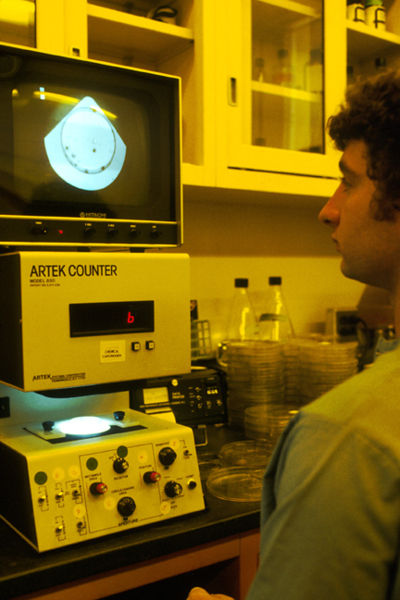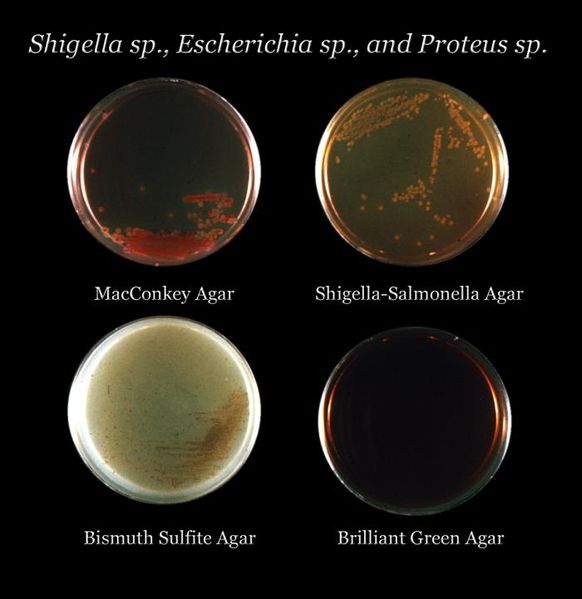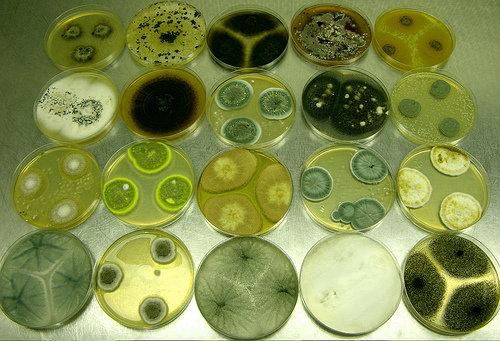Agar plate
Template:Infobox laboratory equipment
Overview
An agar plate is a sterile Petri dish that contains a growth medium (typically agar plus nutrients) used to culture microorganisms. Selective growth compounds may also be added to the media, such as antibiotics.[1]
Individual microorganisms placed on the plate will grow into individual colonies, each a clone genetically identical to the individual ancestor organism (except for the low, unavoidable rate of mutation). Thus, the plate can be used either to estimate the concentration of organisms in a liquid culture or a suitable dilution of that culture, using a colony counter, or to generate genetically pure cultures from a mixed culture of genetically different organisms, using a technique known as streaking. In this technique, a drop of the culture on the end of a thin, sterile loop of wire is "streaked" across the surface of the agar leaving organisms behind, a higher number at the beginning of the streak and a lower number at the end. At some point during a successful "streak", the number of organisms deposited will be such that distinct individual colonies will grow in that area which may be removed for further culturing, using another sterile loop.[1]
For information on agar plate preparation, please visit the Wikibooks Agar Plate page.
Types of agar plates

Like other growth medium, the formulations of agar used in plates may be classified as either defined or undefined; defined medium being synthesized from the individual chemicals as required by the organism so that the exact molecular composition is known, while undefined medium is made up of natural products such as yeast extract, where the precise composition is unknown.[2]
Agar plates may be formulated as either permissive, with the intent of allowing the growth of whatever organisms are present, or restrictive or selective, with the intent of only selecting for growth a particular subset of those organisms.[3] This may take the form of a nutritional requirement, for instance providing a particular compound such as lactose as the only source of carbon for energy and material and thereby selecting only organisms which can metabolize that compound, or by including a particular antibiotic or other substance in order to select only organisms which are resistant to that substance. This correlates to some degree with defined and undefined media; undefined media, made from natural products and containing an unknown combination of very many organic molecules, is typically more permissive in terms of supplying the needs of a wider variety of organisms, while defined media can be precisely tailored to select organisms with very specific properties.
Agar plates may also be indicator plates, where the organisms are not selected on the basis of growth, but a compound in the agar is altered by an enzyme or similar in some colonies so as to change color and identify them from those lacking the enzyme.
Some commonly used agar plate types are:

Blood agar types
- Blood agar plate (BAP)
- Contains mammalian blood (usually sheep or horse), typically at a concentration of 5–10%. BAP are an enriched, differential media used to isolate fastidious organisms and detect hemolytic activity. β-hemolytic activity will show complete lysis of red blood cells surrounding colony, while α-hemolysis will only partially lyse hemoglobin and will appear green. γ-hemolysis (or non-hemolytic) is the term referring to a lack of hemolytic activity.
- Chocolate agar (CHOC)
- A type of blood agar plate in which the blood cells have been lysed by heating the cells to 56 °C. Chocolate agar is used for growing fastidious (fussy) respiratory bacteria, such as Haemophilus influenzae. (No chocolate is actually contained in the plate, it is named for the coloration only.)
- Thayer-Martin agar (TM)
- Chocolate agar designed to isolate Neisseria gonorrhoeae.
General bacterial media

- Bile Esculin Agar (BEA)
- BEA is used for the isolation of Enterococci as well as Group D Streptococci
- CLED agar is used to isolate and differentiate urinary tract bacteria, since it inhibits Proteus species swarming and can differentiate between lactose fermenters and non-fermenters.
- Hektoen Enteric (HE)
- HE agar is designed to isolate and recover fecal bacteria belonging to the Enterobacteriaceae family. HE is particularly useful in isolating Salmonella and Shigella.
- MacConkey agar (MAC)
- A selective and differential media used to differentiate between Gram negative bacteria while inhibiting the growth of Gram positive bacteria. The addition of bile salts and crystal violet to the agar inhibits the growth of most Gram positive bacteria, making MacConkey agar selective. Lactose and neutral red are added to differentiate the lactose fermenters, which form pink colonies, from lactose nonfermenters that form clear colonies. An alternative media, eosin methylene blue (EMB) serves a similar purpose.
- Mannitol Salt Agar (MSA)
- MSA is also a selective and differential media. Mannitol is the differential part, it indicates organisms that ferment mannitol. If mannitol fermentation is occurring, lactic acid will be produced, and the pH will drop causing the MSA plate to turn yellow. The salt portion is selective for halophiles; organisms that cannot withstand a high salt content will be unable to grow.
- Mueller Hinton agar
- Can be blood agar or clear
- Nutrient agar
- Safe to use in school science laboratories because it does not selectively grow pathogenic bacteria.
- Önöz agar

- Önöz agar allows more rapid bacteriological diagnosis as Salmonella and Shigella colonies can be clearly and reliably differentiated from other Enterobacteriaceae. The yields of Salmonella from stool samples obtained, when using this medium, are higher than those obtained with LEIFSON Agar or Salmonella–Shigella agar (SSA).
- Phenylethyl Alcohol Agar (PEA)
- PEA selects for Staphylococcus species while inhibiting Gram-negative bacilli (e.g. Escherichia coli, Shigella, Proteus, etc.).

- TSA is a general purpose media produced via enzymatic digestion of soybean meal and casein; TSA is frequently the base media of other agar plate type, i.e. blood agar plates (BAP) are made by enriching TSA plates with blood (see above).
- TSA plates support growth of many semi-fastidious bacteria, including some species of Brucella, Corynebacterium, Listeria, Neisseria, and Vibrio.
- XLD is used for the culture of stool samples, and contains two indicators. It is formulated to inhibit Gram-positive bacteria, while the growth of Gram-negative bacilli is encouraged. The colonies of lactose fermenters appear yellow.
- It is also used to culture possible Salmonella that may be present in a food sample. Salmonella colonies will show a black halo on XLD.
Fungal media
- Sabouraud agar
- Sabouraud agar is used to culture fungi and has a low pH that inhibits the growth of most bacteria; also contains the antibiotic gentamicin to specifically inhibit the growth of Gram-negative bacteria.
- Hay Infusion agar
- Specific for the culturing of slime moulds (though not technically fungi).
- Potato dextrose agar
References
- ↑ 1.0 1.1 Madigan M, Martinko J (editors). (2005). Brock Biology of Microorganisms (11th ed. ed.). Prentice Hall. ISBN 0131443291.
- ↑ Baron S et al, (editors). (1996). Baron's Medical Microbiology (4th ed. ed.). Univ of Texas Medical Branch. (via NCBI Bookshelf) ISBN 0-9631172-1-1.
- ↑ Ryan KJ; Ray CG (editors) (2004). Sherris Medical Microbiology (4th ed. ed.). McGraw Hill. ISBN 0838585299.
See also
| Wikimedia Commons has media related to Agar plate. |
External links
Template:LaboratoryEquipment simple:Agar plate Template:Jb1 Template:WH Template:WS